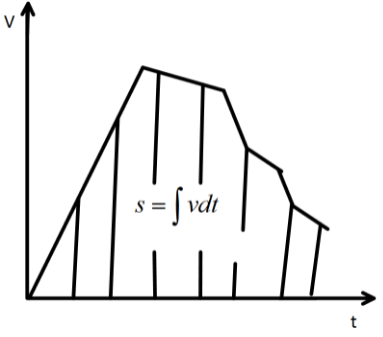
Which part of the velocity time-graph signifies the distance covered by a body?
Answer
504.6k+ views
Hint:Learn the concept of velocity of a body, the acceleration and other different aspects of motion of a body. The velocity of a body is defined by the displacement covered by the body per unit time.
Formula used:
The instantaneous velocity of a body is given by the
\[v = \dfrac{{ds}}{{dt}}\]
where \[v\] is the velocity of the body, \[ds\] is the infinitesimal displacement of the body covered in infinitesimal time \[dt\].
The instantaneous acceleration of the body is given by,
\[a = \dfrac{{dv}}{{dt}}\]
where \[a\] is the acceleration of the body, \[dv\] is the infinitesimal velocity of the body in infinitesimal time \[dt\].
Complete step by step answer:
We know that the velocity of a body is the rate of change of displacement of the body per unit time. Now, when we draw a velocity time graph we plot the velocity along Y-axis and the time along X-axis. So, the slope of the curve is acceleration of the body at a given time. Now, that we can write as, instantaneous acceleration of the body,
\[a = \dfrac{{dv}}{{dt}}\]
Now, we know that, instantaneous velocity of a body is given by the
\[v = \dfrac{{ds}}{{dt}}\]
Now, if we integrate the equation simply we can have, \[s = \int {vdt} \] which is the distance covered by the body.

Now this integration is nothing but the area under the curve since if we simply multiply the length and breadth of a rectangle we get the area of the rectangle. Here the length is the velocity and the breadth is the time.
So, in a velocity time graph the area under the curve represents the distance covered by the body.
Note: In thermodynamics the area under the curve of the P-V curve signifies work done, which is a scalar quantity or in force displacement curve the area under the curve is also work done. In the velocity time graph the area under the curve represents a vector quantity.
Formula used:
The instantaneous velocity of a body is given by the
\[v = \dfrac{{ds}}{{dt}}\]
where \[v\] is the velocity of the body, \[ds\] is the infinitesimal displacement of the body covered in infinitesimal time \[dt\].
The instantaneous acceleration of the body is given by,
\[a = \dfrac{{dv}}{{dt}}\]
where \[a\] is the acceleration of the body, \[dv\] is the infinitesimal velocity of the body in infinitesimal time \[dt\].
Complete step by step answer:
We know that the velocity of a body is the rate of change of displacement of the body per unit time. Now, when we draw a velocity time graph we plot the velocity along Y-axis and the time along X-axis. So, the slope of the curve is acceleration of the body at a given time. Now, that we can write as, instantaneous acceleration of the body,
\[a = \dfrac{{dv}}{{dt}}\]
Now, we know that, instantaneous velocity of a body is given by the
\[v = \dfrac{{ds}}{{dt}}\]
Now, if we integrate the equation simply we can have, \[s = \int {vdt} \] which is the distance covered by the body.

Now this integration is nothing but the area under the curve since if we simply multiply the length and breadth of a rectangle we get the area of the rectangle. Here the length is the velocity and the breadth is the time.
So, in a velocity time graph the area under the curve represents the distance covered by the body.
Note: In thermodynamics the area under the curve of the P-V curve signifies work done, which is a scalar quantity or in force displacement curve the area under the curve is also work done. In the velocity time graph the area under the curve represents a vector quantity.
Recently Updated Pages
Master Class 12 Business Studies: Engaging Questions & Answers for Success

Master Class 12 Economics: Engaging Questions & Answers for Success

Master Class 12 English: Engaging Questions & Answers for Success

Master Class 12 Maths: Engaging Questions & Answers for Success

Master Class 12 Social Science: Engaging Questions & Answers for Success

Master Class 12 Chemistry: Engaging Questions & Answers for Success

Trending doubts
What is meant by exothermic and endothermic reactions class 11 chemistry CBSE

Which animal has three hearts class 11 biology CBSE

10 examples of friction in our daily life

One Metric ton is equal to kg A 10000 B 1000 C 100 class 11 physics CBSE

1 Quintal is equal to a 110 kg b 10 kg c 100kg d 1000 class 11 physics CBSE

Difference Between Prokaryotic Cells and Eukaryotic Cells




